Denmark is a small kingdom in northern Europe that is almost surrounded by water. It consists of a peninsula and 482 nearby islands. The peninsula, called Jutland, shares a 42-mile (68-kilometer) border with Germany. Greenland, off the northeastern coast of Canada, is a province of Denmark even though it lies 1,300 miles (2,090 kilometers) away. The Faroe Islands, north of Scotland, are a self-governing part of the Danish kingdom. Denmark, along with Norway and Sweden, is one of the Scandinavian countries.
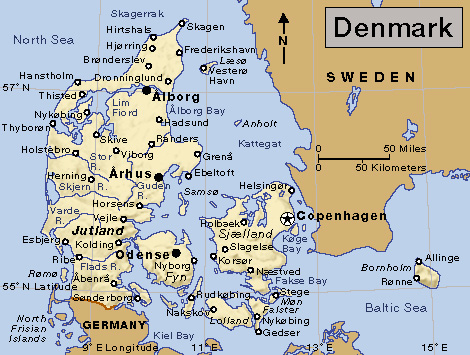
More than half of the Danes (people of Denmark) live on the islands near the peninsula. Copenhagen, the capital and largest city of Denmark, is on the largest island. About a fifth of all Danes live in the Copenhagen area, which is the country’s main commercial and economic center.
Denmark has one of the world’s highest standards of living. The Danes have achieved prosperity even though their land is poor in natural resources. They sell their products to other countries to pay for the fuels and metals they must import for their industries.
Denmark is famous for its butter, cheese, bacon, ham, and other processed foods. The country is also known for its beautifully designed manufactured goods. Denmark produces electronics, furniture, and other high-quality goods. Since the Viking era, the Danes have been a seafaring people, and Denmark is still known as a great shipping and fishing nation.
Denmark has green farmland, blue lakes, and white coastal beaches. The carefully tended farmlands make up about two-thirds of the country. In the farm areas, the roofs of most houses are made of red or blue tiles, or are thatched. Storks, which the Danes believe bring good luck, build nests on some rooftops. Castles and windmills rise above the rolling landscape. Visitors can enjoy Denmark’s charm even in the busy, modern cities, with their well-preserved sections of colorful old buildings and cobblestone streets.
Government
National government.
Denmark is a constitutional monarchy with a king or queen, a prime minister and cabinet, and a parliament. The government is based on the Danish Constitution of 1953, which divides the government into three branches—executive, legislative, and judicial. The monarch serves as head of state but has little real power.
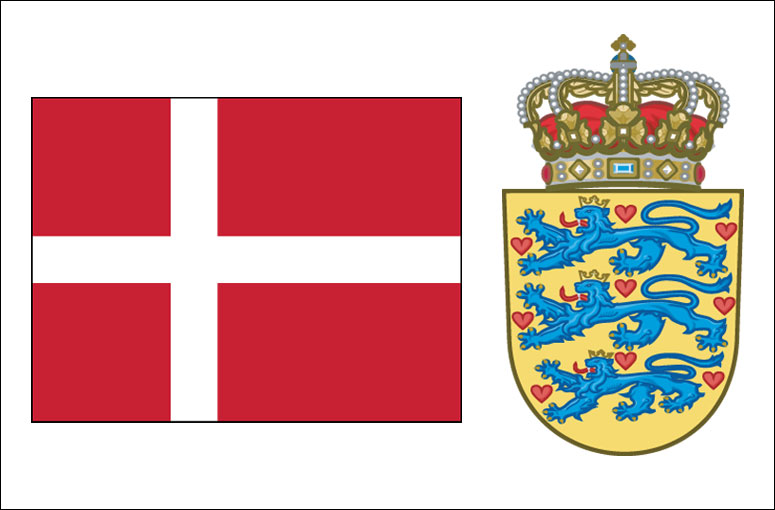
The monarch appoints the prime minister of Denmark. The prime minister must have the support of a majority of the members of the Danish parliament. If one political party controls a clear parliamentary majority, the leader of that party normally becomes the prime minister. However, the large number of parties in Denmark makes it almost impossible for any single party to win a majority. If no party has a majority, the person who can gain the support of the strongest coalition (combination of parties) becomes the prime minister. A prime minister who receives a vote of no confidence from the parliament must either (1) resign, along with the rest of the cabinet; or (2) ask the monarch to dissolve the parliament and call a national election.
Loading the player...
Denmark's national and royal anthem
Loading the player...
Denmark's national anthem
The prime minister heads the cabinet. The cabinet consists of a variable number of ministers, each of whom normally heads a government department. The monarch selects the members of the cabinet based on the prime minister’s recommendations. The main executive powers are exercised by the cabinet in the monarch’s name. However, the cabinet remains in power only as long as it has the support of a majority of the members of parliament.
Other high officials in Denmark, including judges, are named by the monarch on the advice of the cabinet. The parliament appoints an official called an ombudsman, who investigates citizens’ complaints against actions or decisions by the government (see Ombudsman).
The Danish parliament, called the Folketing, consists of one house. It has 179 members, who are elected to four-year terms. One hundred seventy-five are elected from Denmark, 2 from Greenland, and 2 from the Faroe Islands. Of the seats from Denmark, 135 are filled by elections in voting districts, and 40 are divided among the various political parties according to their share of the total votes in the election. All Danish citizens at least 18 years old may vote.
Members of the Folketing discuss and vote on proposed legislation. Certain kinds of bills passed by the Folketing are subject to approval by the Danish voters. The people of Denmark also must be given the opportunity to vote on a bill if one-third of the Folketing’s members call for such action.
Courts.
Denmark’s highest court is the Supreme Court. It consists of 19 judges, at least 5 of whom hear each case. There are two High Courts. At least 3 High Court judges and a jury hear serious criminal cases. Cases from the High Courts may be appealed to the Supreme Court. There are also a Maritime and Commercial Court, a Land Registration Court, several district courts, and courts for the Faroe Islands and Greenland.
Local government.
Denmark was formerly divided into 14 counties and 2 large districts—Copenhagen and Frederiksberg. The 14 counties were subdivided into almost 300 smaller districts. But in 2007, the counties were reorganized and combined into five regions—two in Jutland, two on the island of Sjælland, and one covering the island of Fyn and southern Jutland. Each region has a council of 41 elected officials.
Politics.
Denmark’s two leading political parties are the Liberal Party and the Social Democratic Party. Despite their name, the Liberals support conservative political causes, such as reducing government regulation. The Social Democrats support strong social welfare programs, full employment, and public ownership of the means of production.
Other political parties in Denmark include the Christian Democrats, the Conservative People’s Party, the Danish People’s Party, the Moderates, the Red-Green Alliance, the Social Liberal Party, and the Socialist People’s Party.
Armed forces.
Denmark has an army, navy, and air force. Young men may be drafted for 4 to 12 months’ service in the armed forces.
People
Copenhagen, Denmark’s capital, is also the country’s largest city and municipality. A municipality may include rural areas as well as the urban center. About a fifth of all Danes live in Copenhagen or its suburbs.
Ancestry.
The Danes make up about 85 percent of Denmark’s population. The Danes are closely related to the Norwegians and the Swedes. People of German ancestry live in southern Jutland, along Denmark’s border with Germany. Denmark has ethnic minorities from many countries, including Iraq, Lebanon, Poland, Romania, Syria, Turkey, and Ukraine.
Language.
Danish, the official language of Denmark, is closely related to the Norwegian and Swedish languages. Regional dialects abound and are especially noticeable in northern Jutland and on the island of Bornholm. German is spoken by the ethnic German minority. Virtually all adult Danes also speak English.
Way of life
City life.
The principal cities of Copenhagen, Århus, Odense, and Ålborg feature a striking combination of medieval structures, such as castles and cathedrals, and modern office buildings and homes. Denmark’s high standard of living and extensive social welfare services ensure that the cities have virtually no slums or substandard housing. Most city dwellers live in apartment buildings. Many suburban residents live in single-family houses. Service industries employ most people in urban areas. 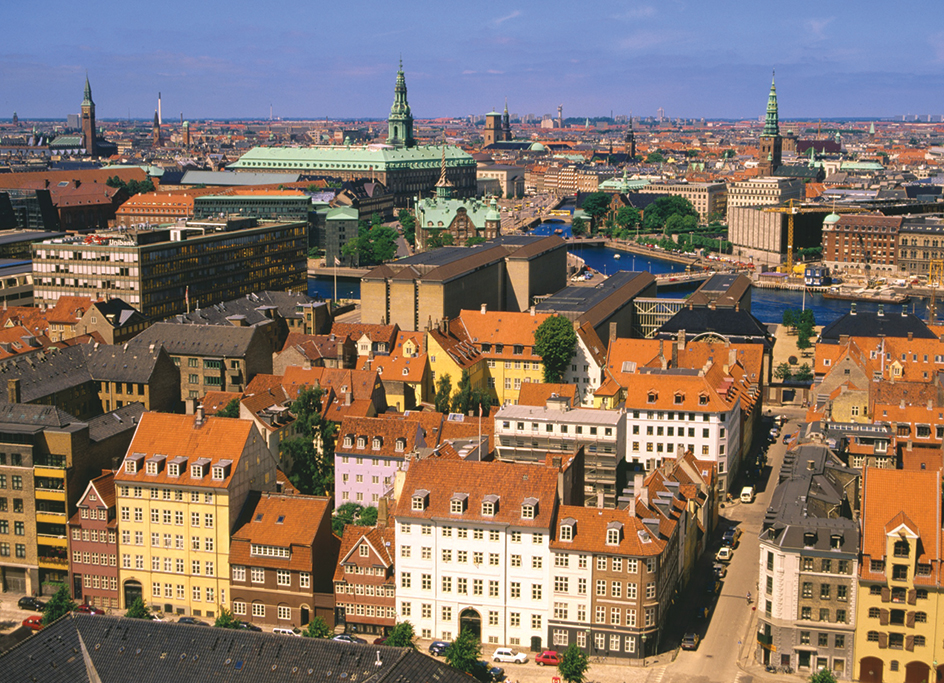
Danish cities are served by an extensive network of public transportation. Modern trains whisk people from the suburbs to the city centers. Trains also link cities to one another. Bicycles, buses, and automobiles provide the chief means of transportation within the cities. The growth of the urban population and the resulting increase in the number of cars and trucks have led to problems of traffic congestion and pollution, especially in Copenhagen. Industrial pollution, however, has decreased, as many urban factories that once burned coal for power now rely on natural gas.
Rural life.
Although cities dominate Denmark’s economic and social life, the nation’s many farms and rural villages show the continuing importance of agriculture. Danish farms are not large, and most are owned and operated by the people who live on them. Most of Denmark’s rural residents live in modernized single-family homes.
Food and drink.
Most Danes eat four meals a day—breakfast, lunch, dinner, and a late-evening supper. Breakfast generally consists of cereal, cheese, or eggs. Dinner, which includes fish or meat, is usually the only hot meal. A favorite traditional Danish dinner consists of roast duckling stuffed with apples and prunes, served with red cabbage and boiled potatoes.
The chief part of the other Danish meals consists of open-faced sandwiches called smørrebrød. One sandwich may be a pyramid-shaped pile of about 20 small shrimps on thin bread. The Danes often prepare a plate of smørrebrød almost as a work of art, with many attractive sandwiches.
Denmark is famous for rich, flaky raised sweet rolls that are often called Danish pastries. Danes especially enjoy a nut-filled coffeecake called kringle. Typical desserts eaten by Danes include berry puddings and rice pudding.
The Danish people typically drink coffee with breakfast and during morning and afternoon breaks from work. Many Danes drink beer with meals. On special occasions, they also may drink aquavit, a strong liquor slightly flavored with caraway.
Religion.
Most of the Danish people belong to the Evangelical Lutheran Church, the official church of Denmark. The monarch is required by law to belong to the church, but the people have complete freedom to worship as they please. The church is supported largely by a national tax paid only by members. The Evangelical Lutheran Church has no supreme spiritual leader. Ten bishops manage church affairs. The Danish parliament has control of the church but does not interfere in its religious practices. Other religious groups include other Protestant denominations, Buddhists, Muslims, and Roman Catholics.
Education.
Almost all adult Danes can read and write. Danish law requires children to attend 10 years of school. Most children attend public schools, called Folkeskole. At the Folkeskole, children complete their compulsory education, which lasts from preschool to year 9, and have the option of completing year 10. Students can then choose to attend 2 or 3 years of upper secondary education. Upper secondary education provides academic courses for those who plan to attend college. It also provides vocational courses. Denmark has several universities. The University of Copenhagen is the oldest and largest. It was founded in 1479. Other universities include those in Ålborg, Århus, Odense, and Roskilde.
The famous Danish folk high schools operate separately from the public educational system. They are private schools but are supported largely by government funds. These schools offer courses in a variety of subjects, including history, literature, and the arts. Courses last up to eight months, and the students live at the schools. The first ones were founded in the mid-1800’s to help young farmers take a more active part in Denmark’s political and social life. Today, the schools also attract many young adults of the cities and towns.
Libraries and museums.
The chief libraries include the Royal Library in Copenhagen, founded in the mid-1600’s. It is Denmark’s national library. Other leading libraries in Denmark include the University Library in Copenhagen, and the State and University Library in Århus. The Danish government supports a nationwide system of public libraries.
Denmark also has hundreds of museums. Many important museums are in Copenhagen. The National Museum houses exhibits that document Danish history from prehistoric through modern times. Fine paintings and sculptures by Danish and other European artists are on display in the State Museum of Art. The New Carlsberg Glyptotek features ancient Egyptian, Etruscan, Greek, and Roman art. The Louisiana Museum, south of Helsingor, is noted for its collection of modern art. The Viking Ship Museum in Roskilde houses five Viking ships dating from the A.D. 1000’s.
Arts.
Many Danes have won fame in the arts, especially in literature. Ludvig Holberg is known as the father of modern Danish literature. During the early 1700’s, he wrote poems and plays that poked fun at Danish society (see Holberg, Ludvig). Johannes Ewald, who did much of his writing during the 1770’s, became one of Denmark’s greatest lyric poets.
Important literary works of the 1800’s include the romantic poems of Adam Oehlenschläger and the hymns of N. F. S. Grundtvig. Hans Christian Andersen won world fame for his fairy tales and is probably Denmark’s best-known writer (see Andersen, Hans Christian). The books of Søren Kierkegaard strongly influenced the development of the modern philosophy called Existentialism (see Kierkegaard, Søren). 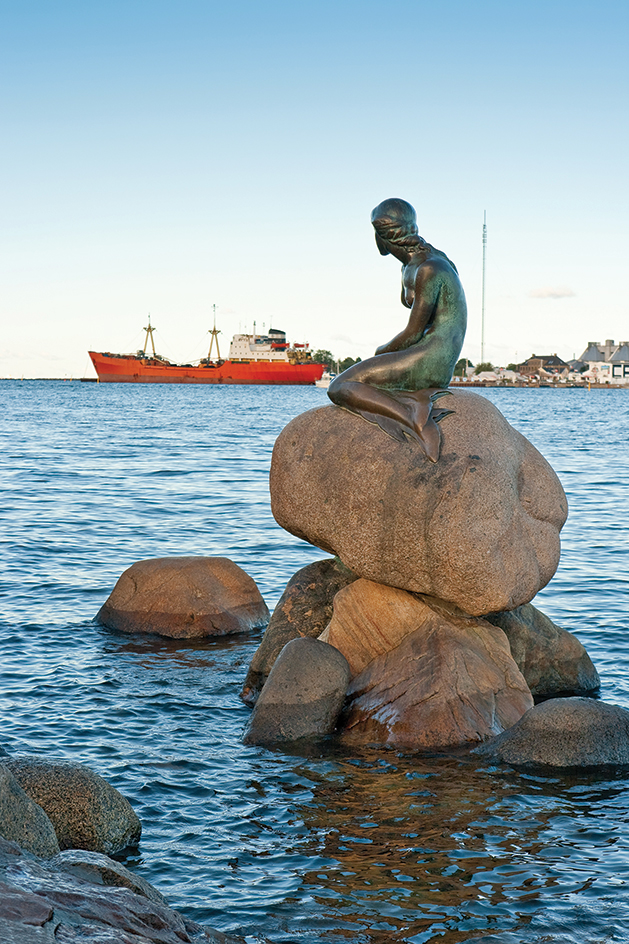
Henrik Pontoppidan and Johannes V. Jensen rank among the most important Danish novelists of the early 1900’s. Each won the Nobel Prize for literature, as did Karl Gjellerup. Other noted Danish writers include Thorkild Bjørnvig, Isak Dinesen, Martin A. Hansen, and Martin Andersen Nexø. See Dinesen, Isak.
Carl A. Nielsen is considered Denmark’s greatest musical composer. He wrote six symphonies and many other works, including the comic opera Maskarade (see Nielsen, Carl A.). In the field of dance, the ballet master August Bournonville made the most significant Danish contribution. The Royal Danish Ballet flowered under his direction during the mid-1800’s, and today it enjoys a worldwide reputation.
Noted Danish painters include Michael Ancher, C. W. Eckersberg, Oluf Høst, Christen Købke, P. S. Krøyer, Theodor Philipsen, and William Scharff. Denmark’s leading sculptor was Bertel Thorvaldsen. His statue of Christ in the Church of Our Lady in Copenhagen is one of his most famous sculptures (see Thorvaldsen, Bertel). 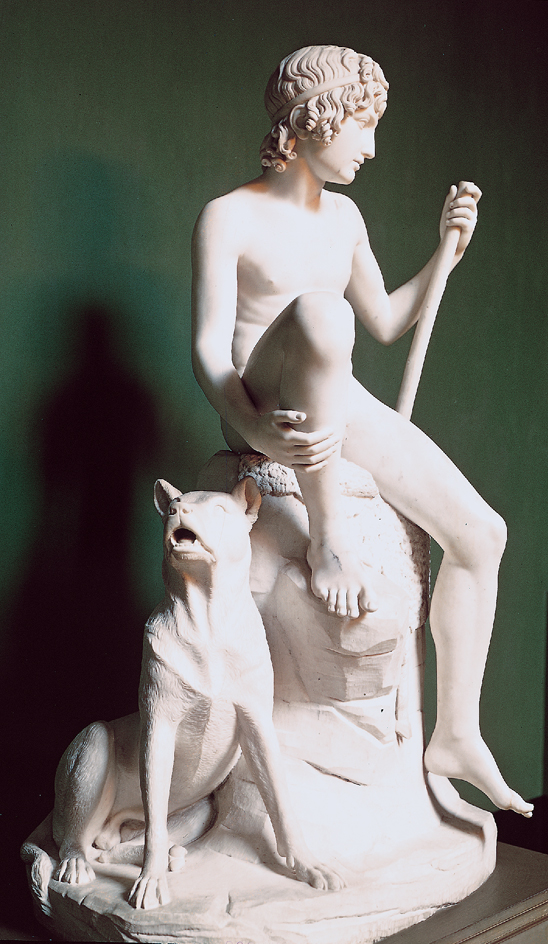
The Danish film director Carl Dreyer is regarded as a major figure in cinema history. His film The Passion of Joan of Arc (1928) is considered a masterpiece. Important Danish filmmakers of more recent years include Bille August, Susanne Bier, and Lars von Trier.
Outstanding works of Danish design include the silverware of Georg Jensen and the furniture of Kaare Klint and Arne Jacobsen. As an architect, Jacobsen became known for his precise grouping of simple structural elements. Jørn Utzon designed the famous sail-like vaults of the Opera House in Sydney, Australia.
Recreation.
Soccer is the most popular sport in Denmark. Other favorite sports include bicycling, gymnastics, rowing, sailing, swimming, and tennis. Danes have won Olympic and other world championships in most of these sports, and also in archery, boxing, diving, fencing, riding, weightlifting, and wrestling.
Copenhagen is world famous for its Tivoli Gardens amusement park, which opened in 1843 in the heart of the city. The park offers ballet and pantomime, rides and shooting galleries, restaurants, circus acts, concerts, and fireworks displays.
Social welfare.
Since the 1890’s, Denmark has developed many social welfare programs. The country has social insurance plans that cover accidents, disabling injuries, illness, old age, unemployment, and the death of spouses. Any person living in Denmark may join these programs. Some plans are managed by private, government-approved organizations, with costs shared by insured persons, employers, and the government. The government manages other plans, including aid for the aged, and pays the total cost.
The land
The peninsula of Jutland accounts for almost 70 per cent of the land in Denmark. However, most Danes live on about 100 nearby islands. The land is low throughout Denmark. The highest point, the hill of Yding Skovhøj on Jutland, rises only 568 feet (173 meters) above sea level. The land is covered mainly by moraine, the earth and stone deposited by melting glaciers thousands of years ago. The underlying rock can be seen in only a few areas.

Land regions.
Denmark has five main land regions: (1) the Western Dune Coast, (2) the Western Sand Plains, (3) the East-Central Hills, (4) the Northern Flat Plains, and (5) Bornholm.
The Western Dune Coast
consists chiefly of great sandy beaches that extend along almost the entire western coast. These beaches close off many long, narrow inlets called fiords that once were connected to the sea. In the southwest are marshes that the tide covers regularly. 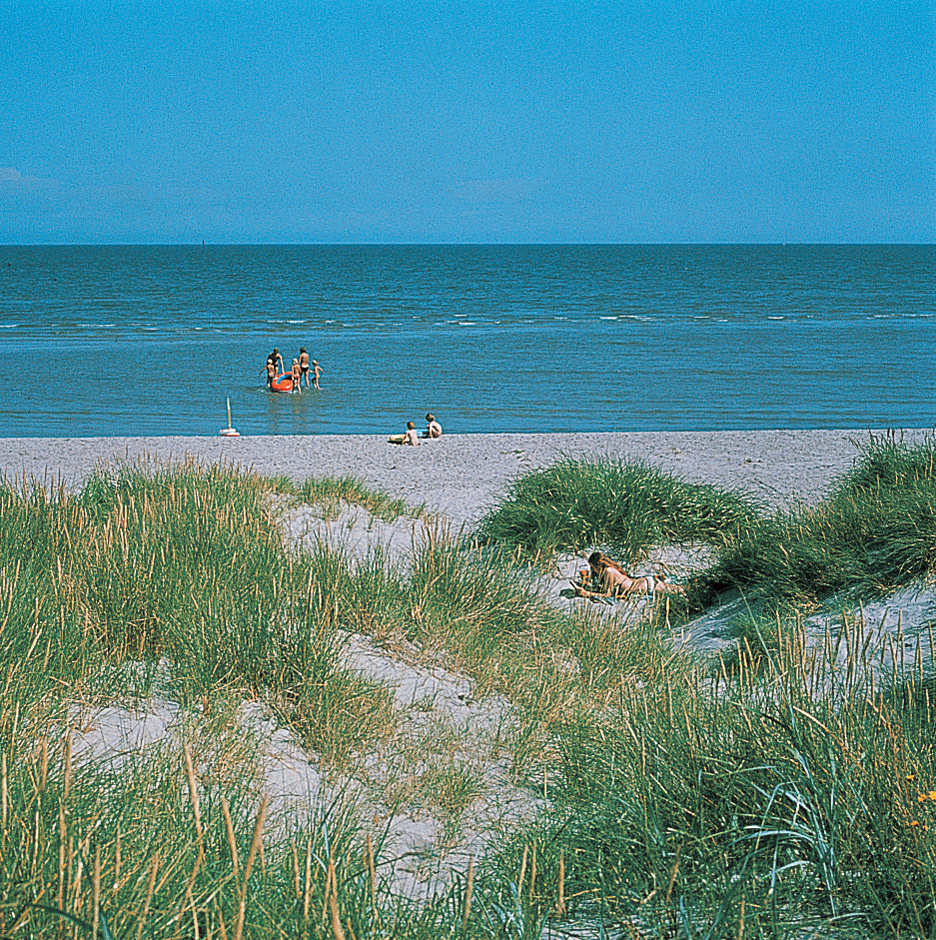
The Western Sand Plains
are almost flat. Water from ancient melting glaciers flowed over this region and deposited much sand, forming the plains.
The East-Central Hills
make up Denmark’s largest land region. This gently rolling region includes much of Jutland and almost all the nearby islands. Long, narrow fiords form natural harbors along the coastlines of the region.
The largest inlet is Lim Fiord, which winds across northern Jutland for 112 miles (180 kilometers). This fiord forms an inland lagoon 15 miles (24 kilometers) wide. A beach on the Western Dune Coast closes off the fiord’s outlet to the North Sea. Small vessels use the Thyboron Canal to travel between Lim Fiord and the sea. 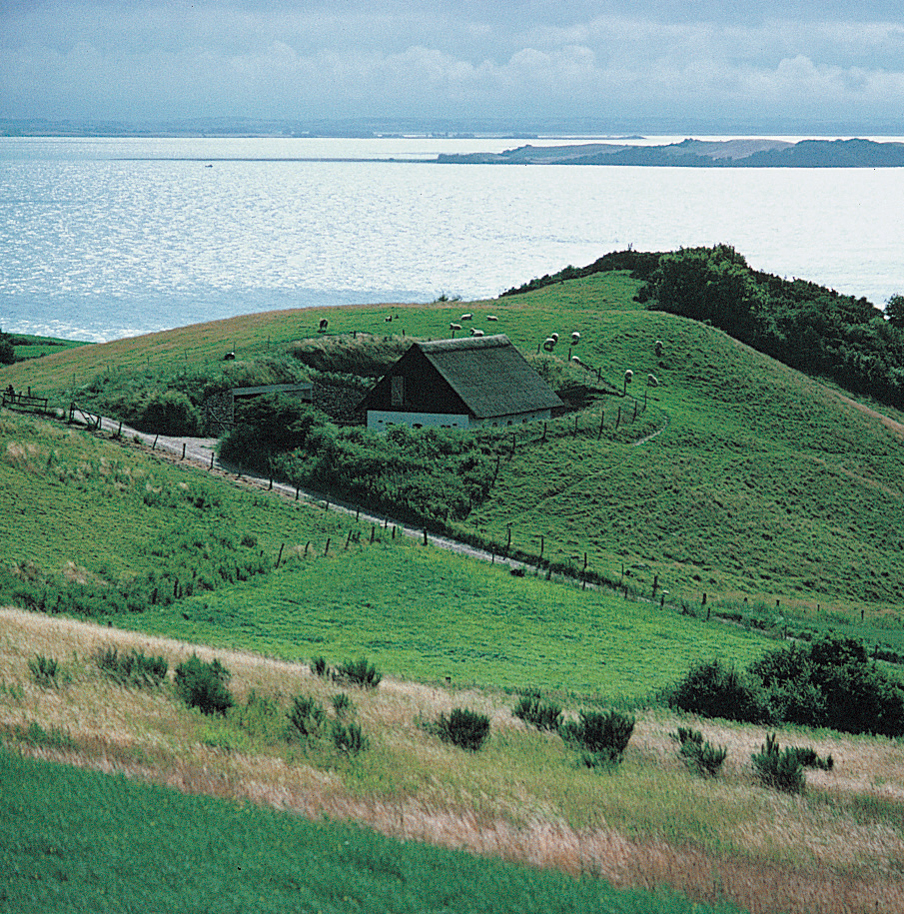
The islands in the region lie close together. Their deep moraine soils are the best farmlands in Denmark. The largest island, Sjælland, is 2,713 square miles (7,027 square kilometers). Sjælland is the most thickly populated part of Denmark. On this island stands most of Copenhagen, Denmark’s capital and largest city. The rest of the city is on the island of Amager. Falster, Fyn, and Lolland are other important islands.
The Northern Flat Plains
were once a part of the sea bottom. The region rose from the water when the weight of ancient glaciers was removed by melting. Many farms are in this region.
Bornholm
and nearby small islands lie much closer to southern Sweden than to the rest of Denmark. Granite rock covers most of this region.
Lakes and rivers.
Denmark has many small lakes. They formed in small hollows left in the ground by melting ice from the glaciers. Lake Arreso, the largest lake, covers 16 square miles (41 square kilometers). Denmark also has many short rivers. The longest one, Guden River, is 98 miles (158 kilometers) long.
Climate
Denmark has a mild, damp climate, chiefly because it is almost surrounded by water. In winter, seas are not so cold as land, and in summer they are not so warm. As a result, west winds from the seas warm Denmark in winter and cool it in summer. These winds affect Denmark’s weather throughout the year. Also in winter, west winds bring some warmth from the North Atlantic Current of the Gulf Stream (see Gulf Stream). Denmark is small, so the climate does not differ much from area to area.
Winter temperatures average about 32 °F (0 °C) in Denmark, with the coldest days from 15 to 20 °F (–9 to –7 °C). The waters on the east may freeze over during especially cold winters. At these times, the waters cannot warm the cold winds and the weather may become bitterly cold. Summer temperatures average 63 °F (17 °C). The warmest weather usually varies from 75 to 82 °F (24 to 28 °C). Winds from eastern Europe may cause higher temperatures in especially hot summers.
Denmark receives a yearly average of about 24 inches (61 centimeters) of precipitation (rain, melted snow, and other forms of moisture). Western Denmark gets a little more precipitation than eastern Denmark because the moisture-bearing west winds reach it first. Rain falls throughout the year, with the most during August and October. Snow falls from 20 to 30 days a year, but usually melts quickly. Fog and mist occur frequently, especially on the west coast in winter.
Economy
Denmark has a strong economy, even though the country is poor in natural resources. Denmark obtains natural gas and petroleum from wells in the North Sea. Other products mined in Denmark include chalk, clay, and peat. Coal, as well as iron and most other metals, must be imported. Much of the soil in Denmark lacks nutrients, so it requires heavy use of fertilizers to make it productive.
For hundreds of years, windmills have been a prominent feature in the Danish landscape, turning grindstones and other agricultural devices. Windmills today are generating an increasing amount of Denmark’s electric power. The seas that almost surround Denmark provide an inexpensive means of transportation by which Denmark can import its industrial needs and export its products. The seas are also rich in fish.
Service industries
employ about four-fifths of the Danish labor force and account for over three-fourths of the country’s gross domestic product (GDP)—the total value of goods and services produced within a country in a year. Community, government, and personal services, and finance, insurance, real estate, and business services are the country’s leading service industries. Hotels, restaurants, and shops are helped by the millions of tourists who visit Denmark from Germany, Norway, Sweden, and other countries.
Manufacturing
is an important economic activity. Since the late 1900’s, however, manufacturing’s share of Denmark’s total GDP and employment has declined.
Danish factories produce high-quality goods, including electronics and furniture. Among Denmark’s other products are machinery; paper products; pharmaceuticals (medicinal drugs); wind turbines; and butter, cheese, bacon, ham, and other processed foods.
Agriculture.
Farmland makes up about two-thirds of Denmark’s total land area. Much of Denmark’s farm production comes from Jutland. Livestock products account for over half of Denmark’s agricultural production. Danish farmers raise beef and dairy cattle, chickens, and hogs. Pork products are among Denmark’s leading exports. Much of the country’s crop production is used for livestock feed. Leading crops include barley, carrots, oats, onions, potatoes, rapeseed, rye, sugar beets, and wheat.
Fishing.
Since the mid-1990’s, the amount of fish that Denmark’s fishing crews have caught has decreased. Over half of Denmark’s total fishing catch is taken from the North Sea. Important fishing catches include blue mussels, cod, herring, lobsters, mackerel, plaice, prawns, sprat, and whiting.
International trade.
Denmark exports more than it imports. The country’s main exports include machinery, meat and other food products, petroleum products, and pharmaceuticals. The country imports food, machinery, petroleum products, and transportation equipment. Denmark’s main trading partners include Germany, the Netherlands, Norway, Sweden, the United Kingdom, and the United States.
Transportation.
Denmark has an excellent road system. Many roads have separate bicycle lanes because many people use bicycles for transportation. A government-owned railroad provides fast passenger service to most cities and towns.
Ferries, bridges, and underwater tunnels connect Danish islands with each other and with the mainland. The Storebælt Bridge spans the Great Belt waterway between the islands of Fyn and Sjælland. The Øresund Link is a bridge and tunnel connection between Copenhagen in Denmark and Malmö, Sweden. The link serves railroad trains as well as automobiles.
Denmark has large seaports at Ålborg, Århus, and Copenhagen. Copenhagen also has the country’s busiest international airport. Other large international airports are at Ålborg, Århus, and Billund, which is near Vejle.
Communication.
Denmark has numerous daily newspapers. The largest dailies include the Berlingske Tidende, B. T., Ekstra Bladet, Morgenauisen Jyllands-Posten, and Politiken, all of Copenhagen.
Denmark’s main radio and television broadcasting is handled by the government. Commercial radio and television stations broadcast local and national programming. Denmark has one of the highest internet usage rates in the world. Cell phones are increasing in popularity in Denmark.
History
Early days.
As long as 100,000 years ago, people lived in what is now Denmark. Great changes in the climate occurred, and the region became too cold for human life. The climate started to become warmer about 14,000 years ago, and continuous settlement began. Farming developed in the region about 3,000 B.C.
By the time of Christ, trade by sea had brought the people into close contact with leading civilizations. The contact expanded for hundreds of years. During this period, the Danes lived in small communities governed by local chieftains. In the mid-900’s, all Denmark was united by King Harald Bluetooth. Harald fostered the spread of Christianity in Denmark.
About 800, Danish seafarers began raiding European coastal towns and sailing away with slaves and treasure. The Danish Vikings spread terror throughout much of western Europe for about 300 years. The Vikings gained control of England in 1016, and Danish kings ruled that country until 1042. See Vikings (The Danish Vikings).
A great power.
During the late 1100’s and early 1200’s, Danish power expanded along most of the southern coast of the Baltic Sea. Denmark conquered northern Estonia in 1219. But a long period of civil wars and struggles with north German cities, beginning in the 1240’s, greatly weakened the country.
Denmark regained its power under Queen Margaret, who became queen of Denmark as regent (temporary ruler) for her young son in 1376. Margaret was also the wife of King Haakon VI of Norway. After he died in 1380, Margaret became regent of Norway as well as Denmark. In 1388, during political confusion in Sweden, Swedish nobles elected her to rule that country, too. In 1397, Margaret united Denmark, Norway, and Sweden in the Union of Kalmar, with power centered in Denmark. Sweden broke away from the union in 1523.
In 1536, during the Reformation, King Christian III established Lutheranism as the official religion of Denmark. That same year, Christian made Norway a province of Denmark.
Wars with Sweden.
During the 1600’s and 1700’s, Sweden defeated Denmark in several wars fought for control of the Baltic Sea. In the Danish-Swedish War (1657-1660), Sweden won a great deal of Danish and Norwegian territory in what is now Sweden. Only pressure from England, France, and the Netherlands prevented Sweden from dividing Denmark itself. In the Great Northern War (1700-1721), Denmark tried unsuccessfully to win back the territory it had lost to Sweden.
In 1788, Denmark began freeing its serfs. These peasants had been bound to the land on which they worked. Educational reforms were begun during the early 1800’s. Denmark sided with France in the Napoleonic Wars of that period and was defeated by Sweden in 1813. By the terms of the Treaty of Kiel in 1814, Denmark gave Norway to Sweden but kept Greenland and other Norwegian colonies.
The Schleswig wars.
In 1848, the pressure of public opinion forced King Frederik VII to accept a democratic constitution for Denmark. The constitution was adopted in 1849. It granted the highest power of government to an elected two-house parliament.
Also in 1848, a revolt broke out in Holstein and Schleswig, two Danish duchies located just south of Denmark. These regions were ruled by the Danish king, though they were not part of Denmark. A revolutionary government of Schleswig-Holstein was established. The government wanted to throw off Danish control and join the German Confederation. Holstein was already a member. Danish troops defeated the rebels in 1850. In 1863, Schleswig was made a part of Denmark. Prussia and its ally, Austria, invaded Denmark in 1864. They won a quick victory and took over Schleswig and Holstein.
Social and political reforms.
During the late 1800’s, education, industry, and trade were expanded in Denmark. The Danes also developed cooperatives and improved their farming methods. At this time, the upper classes had special rights that gave them control of the upper house of the parliament. The small farmers and industrial workers formed political parties and struggled for political equality. A new constitution was adopted in 1915 during the reign of Christian X, who was king from 1912 to 1947. By the terms of the constitution, the special rights of the upper classes were abolished, and Denmark became a parliamentary democracy.
Denmark remained neutral during World War I (1914-1918). After the war, Denmark granted independence to Iceland, a Danish colony. However, Iceland stayed united with Denmark until 1944, when it became a republic. In 1920, the Allies transferred North Schleswig to Denmark from Germany. Most people of the region had voted for the transfer.
World War II
began in 1939. On April 9, 1940, German forces invaded Denmark, and the Danes surrendered after a few hours of fighting. The Germans allowed the Danish government to continue as long as it met their demands. But resistance groups developed and blew up factories and transportation facilities. The Germans took over the government in August 1943.
In September 1943, the Danes organized the secret Freedom Council to lead the resistance movement. They also helped about 7,000 Danish Jews escape to Sweden. On May 5, 1945, after the fall of Germany, Allied troops entered Denmark, and the Germans there surrendered.
Denmark became a charter member of the United Nations in 1945 and of the North Atlantic Treaty Organization (NATO) in 1949. During the late 1940’s, the United States gave Denmark much aid. The Danes rebuilt industries that had been damaged during the war, and the nation’s economy became strong again.
Postwar years.
Political reform and economic expansion in Denmark continued during the 1950’s and 1960’s. In 1953, a majority of Danish voters approved a new constitution that abolished the upper house of parliament. The constitution also made Greenland a province of Denmark, rather than a colony. In addition, Danish voters approved a law that permitted both males and females to inherit the throne.
In 1960, Denmark and six other countries—Austria, Norway, Portugal, Sweden, Switzerland, and the United Kingdom—formed the European Free Trade Association (EFTA). EFTA regulates and promotes trade among its members (see European Free Trade Association). Denmark resigned from EFTA in 1972. In 1973, the country entered the European Community, an economic association of European nations.
In 1966, Denmark launched a massive economic development program in Greenland. The program called for the expansion and modernization of the towns and of the fishing and food-processing industries. In 1979, the Danish parliament granted home rule—that is, the power of local self-government—to Greenland.
King Frederik IX died in 1972. His oldest daughter, Margrethe, succeeded him to the throne.
The late 1900’s.
During the 1970’s and early 1980’s, Denmark—like many countries—faced an economic recession. Economic growth slowed, and unemployment and inflation increased sharply. Several political parties gained support as many voters expressed their frustration over the economy. In 1982, a Conservative-led coalition government replaced the government of the Social Democrats. The Social Democrats had held power either alone or as part of a coalition for most of the time since the end of World War II in 1945.
In 1993, Denmark and the other members of the European Community formed the European Union (EU) to increase economic and political cooperation among themselves. At that time, the European Community was incorporated into the EU.
A coalition led by the Social Democrats regained control of the government in 1993. The economy improved under the coalition, but Denmark still faced problems of environmental pollution, unemployment, and the high cost of welfare services.
Recent developments.
In 2000, voters in Denmark rejected the proposal to adopt the euro, the EU’s common currency. Many Danes believed that closer ties to the EU would weaken both Denmark’s economy and its national identity.
In 2001, the Liberal Party gained control of Denmark’s government and established a coalition with other parties. The Liberal Party and its coalition favored right-wing conservative policies. The Liberal Party remained in power until 2011 elections, when they were defeated by a center-left coalition led by Social Democrat Helle Thorning-Schmidt. Thorning-Schmidt became Denmark’s first woman prime minister. Right-wing groups made large gains in 2015 elections, forcing Thorning-Schmidt from office. Opposition leader and former prime minister Lars Løkke Rasmussen then formed a coalition government.
Following elections in 2019, Social Democrat Mette Frederiksen formed a coalition government and became prime minister. But the coalition collapsed in 2022. Elections then were held in November of that year. The Social Democrats and their political allies won a small majority of seats in the parliament. However, Frederiksen disbanded the government and resigned as prime minister, with the intention of forming a broader coalition. In December, the Social Democrats formed a centrist coalition with the Liberal Party and the Moderates. Frederiksen remained prime minister.
Queen Margrethe II stepped down from the Danish throne in January 2024. Her son Frederik became King Frederik X.
